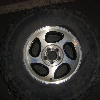- Joined
- March 29, 2015
- Messages
- 566
- Reaction score
- 292
- City, State
- Orangevale, California
- Year, Model & Trim Level
- 2015 Ford Explorer Sport
Removal And Installation Of The Intake Manifold
Original Post: How to: - Removal And Installation Of 2015 Sport Intake Manifold
I ended up doing this for multiple reasons. Installation of XDI +30% fuel injectors, installation of the X35Designs phenolic spacer, installation of the BBK 70mm throttle body, some heat management of the coolant passage underneath the manifold and finally, installation of my new port injection methanol intake manifold.
It isn't necessarily hard, just tedious and time consuming. I won't cover the injector install in this thread as that will get covered in another one, just the basic removal, prep and install of the intake manifold. I also performed the port matching of the phenolic spacer during this, but it is also covered in another thread.
Phenolic spacer thread: HOW-TO: X35Designs Phenolic Spacer Improvement..
Getting her ready:


Removal of the hood made it easier to access everything and wasn't hard at all. It only weighs about 20lbs:

Here's part 01, removal video:
How it looks right after removal:

Here's part 02, preparation video:
All prepped:

At this point, I completed the swap-over of the components off the stock throttle body onto the BBK one. There's a spring in there and some clocking that is necessary...
Ready for the intake manifold:

Here's part 03, installation video:
Got it going in:

Before Shot:

After Shot:

And a side-by-side comparison:

Original Post: How to: - Removal And Installation Of 2015 Sport Intake Manifold
I ended up doing this for multiple reasons. Installation of XDI +30% fuel injectors, installation of the X35Designs phenolic spacer, installation of the BBK 70mm throttle body, some heat management of the coolant passage underneath the manifold and finally, installation of my new port injection methanol intake manifold.
It isn't necessarily hard, just tedious and time consuming. I won't cover the injector install in this thread as that will get covered in another one, just the basic removal, prep and install of the intake manifold. I also performed the port matching of the phenolic spacer during this, but it is also covered in another thread.
Phenolic spacer thread: HOW-TO: X35Designs Phenolic Spacer Improvement..
Getting her ready:
Removal of the hood made it easier to access everything and wasn't hard at all. It only weighs about 20lbs:
Here's part 01, removal video:
How it looks right after removal:
Here's part 02, preparation video:
All prepped:
At this point, I completed the swap-over of the components off the stock throttle body onto the BBK one. There's a spring in there and some clocking that is necessary...
Ready for the intake manifold:
Here's part 03, installation video:
Got it going in:
Before Shot:
After Shot:
And a side-by-side comparison:










